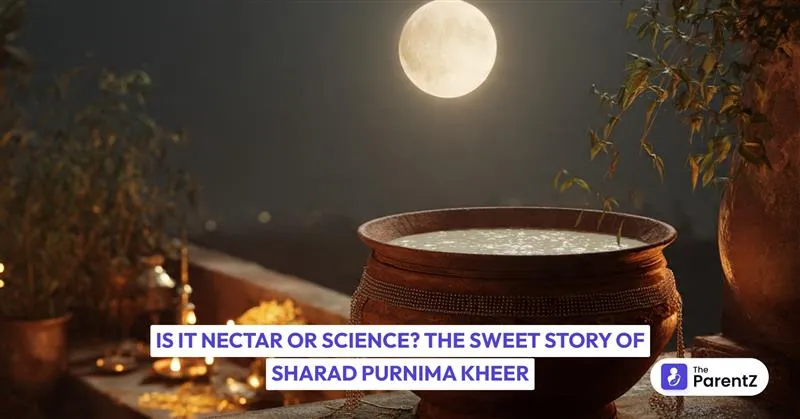Imagine this: it’s a cool October night, the moon is shining at its brightest, and in almost every Indian home, a bowl of kheer is placed under the open sky. Why? Because it’s Sharad Purnima! A night when myths meet science, and faith stirs softly into a pot of milk and rice. Most of us have grown up watching our elders perform this ritual, but do we truly understand why it’s done? So, today, let’s explore the story behind Sharad Purnima Kheer.
The Magical Night of Sharad Purnima
Sharad Purnima falls on the full moon night of the Indian month of Ashwin, which usually comes around October. But this isn’t an ordinary full moon. It’s believed that on this particular night, the moon is closest to the Earth and shines with all its sixteen phases complete, making its light extra pure and powerful.
According to scriptures, on this very night, Goddess Lakshmi, the Goddess of wealth and prosperity, descended to Earth. That’s why homes are lit with lamps and filled with prayers to welcome her. It’s also said that Lord Krishna performed his divine Maharas with Radha and the Gopis in Vrindavan during this full-moon glow. This is why the night is not just about wealth or worship; it’s also about love, happiness, and gratitude.
Why Do We Keep Kheer Under the Moonlight?
This is the heart of the tradition, the famous kheer kept under the open sky. It’s believed that on Sharad Purnima, the moon showers nectar, or amrit, on Earth through its rays. When this moonlight touches the kheer, it soaks up these celestial blessings. Eating it the next morning as prasad is said to bring good health, peace, and happiness to the family.
Children often wonder, Does nectar really fall from the sky? Elders smile and say, “Yes, but not the kind you see; it’s the one you feel.” But interestingly, there’s also a scientific side to this centuries-old ritual.
The Science Behind the Nectar
Modern science and Ayurveda both find sense in this beautiful tradition. Sharad Purnima comes just after the monsoon, when the air starts cooling and humidity reduces. The moonlight on this night carries high intensity and pleasant cooling energy, owing to the moon’s closest position to Earth.
When kheer, made of milk and rice, is kept under this moonlight, two things happen:
- Cooling effect: The moon’s rays reduce internal body heat and calm the nerves when the kheer is consumed the next day.
- Medicinal absorption: The combination of milk (rich in calcium, tryptophan, and lactic acid) and rice (carbohydrates that help absorb energy) acts like a natural detoxifier.
- Immunity boost: Adding dry fruits and saffron to the mix enhances its immunity-building properties.
According to Ayurveda, the moon is associated with the mind. So, when food is infused with the moon’s gentle energy, it helps improve mood, mental peace, and sleep quality. So yes, your grandmother’s midnight kheer recipe has both faith and science stirred in equal measure!
The Rituals And Their Charm
On Sharad Purnima night, people prepare the kheer, usually made from full-fat milk, rice, sugar, and cardamom, and pour it into a silver or earthen bowl. Why silver? Because ancient belief says silver not only preserves purity but also enhances the immunity properties of food. Then the bowl is placed in the moonlight, often on the terrace or balcony, uncovered or loosely covered with a fine cloth to let the rays fall directly.
Families stay awake late, singing bhajans, lighting lamps, and praying to Goddess Lakshmi. This act of staying awake is called Ko-Jagriti, meaning “Who is awake?” because, as legend says, Goddess Lakshmi visits homes that remain lit and awake in her honor.
The next morning, after offering prayers to Goddess Lakshmi and Lord Vishnu, the kheer is eaten as prasad. Many also distribute it among neighbors and friends, spreading sweetness, literally and spiritually.
Teaching This Tradition to Kids
Today’s children see Sharad Purnima as a “moon and dessert” festival, which is a great start! But helping them understand why it’s done can make them appreciate the depth of their culture. You can make it fun for them:
- Let them help stir the kheer and talk about how milk symbolizes purity and calmness.
- Take them out under the full moon, show its glow, and explain that the same light touches everyone, teaching equality and divine connection.
- Tell them that traditions are not just old stories; they are also smart ways our ancestors cared for health and happiness.
This turns a sweet dish into a sweet life lesson.
So, Is It Nectar or Science?
Maybe it’s both. Maybe the nectar people believed in was the same natural energy that modern science talks about today. Sharad Purnima brings together belief and biology, divinity and digestion, devotion and delight; all in one bowl of creamy, moonlit kheer.
This year, as you step onto your balcony under the glowing full moon, place the bowl of kheer outside with gratitude in your heart. Whether you call it nectar or science, one thing’s certain: it’s a tradition that connects our bodies, minds, and hearts under one bright sky.








Be the first one to comment on this story.